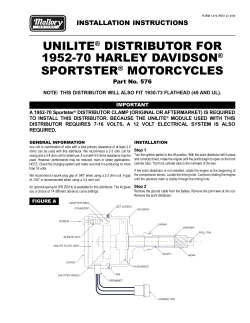
A REPRODUCEABLE SLIM JIM FOR 2 m
A REPRODUCEABLE SLIM JIM FOR 2 m Starting from scratch. I recently decided to build another Slim Jim J-pole. Previous ones were made from 300 ohm feed line in a sealed PVC tube and another made from aluminium tube. I have to say that while they worked the SWR was higher than I thought it should be – up around 2:1. I had also tried to make one out of 50 ohm coax, but it was a dismal failure. So now having been given a few metres of slotted 300 ohm feeder I decided to have another go. This time I went to the web for design information as I did could not find my previous dimensions. Designs, designs and more designs. Well it seems there are more experts on J-poles than almost any other antenna. One gentleman even spent months writing an article but did not actually make one. The dimensions were as varied as the designs were numerous making selection difficult. The tapping points varied from 35 to 100 mm and radiator lengths from 850 to 991 mm. Could I find at least three identical designs that had believable numbers? As I was nearing exhaustion after wading through the mire of advice I found an article based on calculations by Gary O’Neil N3GO. Engineering principles. Gary had actually approached the design from a radio engineer’s perspective. He also was going to use 300 ohm TV ribbon which was what I had, albeit of the slotted kind. Firstly he A REPRODUCEABLE SLIM JIM FOR 2 m cont’d determined the length of a resonant half wave AND its end impedance. This he estimated to be 3,500 ohms (for 12 gauge wire) to 7,000 ohms maximum for thinner wire. As an approximation, which turns out not to be a critical one, he took a value of 5,000 for the design. He then plotted this value on a Smith Chart, the preferred design tool for transmission problems. More than a quarter wave. He found that the distance along a 300 ohm feed line at which the end resistance was transformed to 50 ohm was less than a quarter wave. So far so good. BUT it had 48 ohms of capacitance reactance in shunt. To remove this requires a resonating inductance across the feed point yielding a 50.0 ohm feed point. The inductance can be a small coil, loop or a small length of transmission line shorted at one end. Now you might say this is the same as tapping up from the bottom of a shorted quarter wave matching line. No it isn’t. The total length exceeds a quarter wave by a little. The idea that connecting a resistive load across the open end of a shorted quarter wave transmission line will allow it to be perfectly matched by selecting tapping points is shown to be incorrect. The line impedance matters and the quarter wave line is not the same as a tapped tuned circuit. With the tuned circuit match we tune out the reactance. With the transmission line match we need to add our own reactance. However, because in the past many people fiddled with the different lengths and tapping points they eventually got acceptable results. A REPRODUCEABLE SLIM JIM FOR 2 m cont’d Gary investigated the use of 450 and 200 ohm lines and found these were not optimal. I now know why my simple 50 ohm transmission line J pole failed. Interestingly enough it should be possible to match an end fed antenna with just a quarter wave line (no short) if its spacing were adjusted to give the impedance given by: ZL = √(Z1 Z2) Where ZL is the matching line impedance, and Z1 = 50 ohms and Z2 = end resistance of the half wave ( in the range 1,000 to 7,000 ohms depending of radiator thickness. For a 50 ohm match to a 5,000 ohm load the transmission line impedance required is 500 ohms. If the antenna feed resistance were 4,000 ohms the 450 ohm line would be just right. If the antenna feed resistance were 1,800 ohms then 300 ohm line would be just right. The critical bit. Many 300 ohm designs have worked very well as it is close to optimum for the J-pole. The critical parameter is the velocity factor. Once the right dimensions have been found the design is easily duplicated with excellent results. A REPRODUCEABLE SLIM JIM FOR 2 m cont’d Measuring the velocity factor is the best approach but the next best is the manufacturer’s data. If all else fails start with a factor of 0.82. Incidentally the typical all metal design is intrinsically unbalanced due to the asymmetric grounding of the bottom of the nominal quarter wave matching section. Also the line impedance is nearer 200 ohms than 300 so although an acceptable match is more likely to be achieved for a fat radiator. I was in a hurry so I calculated the lengths for the matching section based on an assumed velocity factor and an estimated length for the inductance. The radiator length was based on the free space length of a wire plus a margin. Success by sidecutters. I hung the antenna from the clothes line by some fishing line and pruned the radiator with my sidecutters, checking the VSWR on my bridge after each snip. The SWR between 146 and 147 MHz fell to 1.2:1 which I was happy with, especially as I had been a bit slap-dash by not checking the velocity factor carefully. I could have spent more time fiddling to do better but I thought this close enough. . A REPRODUCEABLE SLIM JIM FOR 2 m cont’d Hiding beneath a bushel, or a radome. I then inserted the assembly in a 16 mm ID PVC electrical conduit which was to serve as a radome and support. The resonance fell to 142 MHz. More use of the side cutter on the radiator restored the resonance with a very slight reduction in bandwidth. Gary also had the same 4 MHz drop in resonance and like me ignored the effect on the matching and merely cut the radiator shorter. Gary states very clearly that once the length of the 300 ohm matching section and the shunt inductance have been found, tuning is simply by adjusting the dipole length. There is no need to adjust the tapping point! I found this to be correct. Feedline radiation. I found as Gary did that there was very little unbalance in the coax feed line – the SWR moved a needle thickness when I ran a closed hand along the coax.- so I did not include the 4 or 5 turn coil around the conduit used by many builders. The question arises which side to put the braid. It probably doesn’t matter much but Gary says connecting it to the short side of the J is slightly better. I wasn’t going to argue about this as he was right in every other aspect. A REPRODUCEABLE SLIM JIM FOR 2 m cont’d Fig 1. J-Pole details. If you are not going to use a tight fitting radome for minimum visibility the radiator will be longer. Start with A = 980 mm and prune back for resonance near 146.5 to 147 MHz. For the radome used the length of A reduced to 858 mm. It will be sufficient to use B = 4 mm, C = 395 mm and D = 33 mm. Connect the screen of the RG58 to the cut side of the ribbon and the inner to the other side. Keep these leads less than 5 mm long. If your 300 ohm feedline isn’t slotted the dimensions given are a good guide. A REPRODUCEABLE SLIM JIM FOR 2 m cont’d On air results. I tried the antenna against a rubber ducky at the same height. On 2 m the difference was very substantial with repeaters being triggered on low power when high power was not always enough on the rubber ducky. This is as we would expect. 70 cm? Gary says it won’t work on 70 cm and I can see that the matching would be way out. Nevertheless I tried it anyway. On 70 cm the J-pole at best was very marginally better than the rubber ducky. I did not measure the VSWR but expect it would be high and hence while the antenna may be used for listening it is not a good antenna for transmitting use on 70 cm. These do not represent exhaustive scientific tests by any means. It just means that most of the power going into the coax is probably radiated and the antenna works as a 2 m half wave might be expected to do. How well will it contain the smoke? The antenna should have low losses even though the matching section has an effective VSWR of about 17:1. I believe it should be comfortable with 50 watts input. A stealth version. The plan is to use it at another QTH but install it so it is unobtrusive. The radome I plan to use (the bits are in the garage) is a length of grey electrical conduit fitted into a mast section of 33 A REPRODUCEABLE SLIM JIM FOR 2 m cont’d mm grey electrical conduit. It is to be placed inside a tree with the radiator sticking above the foliage. This will intrinsically be low visibility but it might be necessary to use cable ties to fit some dead twigs along the top section if a complete stealthy system is required. The radiator could be concealed in the foliage if the neighbours are a problem but this will result in some signal loss. The grey conduit does not have significant rf losses in spite of what many say. It passes the microwave oven test easily. A more elaborate stealth radome with plastic vines (available in bargain basement shops for a couple of dollars) covering the conduit could be assembled if necessary. Paint the conduit brown or green. Many cities hide their mobile phone towers in steel and fiberglass “palm trees”; they are much taller and straighter than real palms and do not take much sussing out but apparently it goes over well with the citizens. There was at least one “oak tree” cell phone tower in Melbourne. A flagpole made from white PVC tubing could be used. Who is going to challenge a patriot? Just don’t forget the flag must be lowered at night. You might only raise it once a week or on special occasions. I believe you can justify an 8 m pole without council approval. (Flight paths might have some extra restrictions but if it hits an 8 m pole the plane wasn’t going to reach the runway anyway.) Water, water everywhere. I gave all exposed wire a spray of clear enamel paint to retard corrosion. Expect condensation on antennas even when enclosed. This is adequate when enclosed in a radome. A thin A REPRODUCEABLE SLIM JIM FOR 2 m cont’d covering of silastic would suffice for exposed antennas or you might use the special red insulation coating spray used by some auto electricians. The radome enclosed version will outlast one exposed to the full blast of the sun’s UV rays. Reproducibility The design seems to be quite reproducible with other M&DRC members duplicating the results with the same dimensions. This item is based on an article first published in M&DRC magazine, APC News No 205, Sept Oct 2009.
© Copyright 2025





















